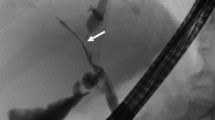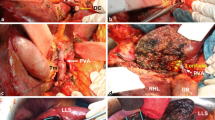Summary
Background: Surgical resection provides the only chance of cure for patients suffering from hilar cholangiocarcinoma. Although appropriate procedures are not agreed upon, an increase in radicality has been observed during the past 20 years.
Methods: The literature as well as our own experience after 80 resections of hilar cholangiocarcinomas were reviewed retrospectively.
Results: Tumor-free margins represent the most important prognostic parameter. Hilar resections as least radical resective procedure will generate rates of formally curative resections of less than 50%. Curative resection and 5-year survival rates after additional hemihepatectomy generally do not exceed 65% and 25% in the more promising reports, respectively. In our series, the best 5-year survival rate was achieved after right trisegmentectomy with 59%. After conventional liver transplantation, 5-year survivors can only exceptionally be observed. Although extended bile duct resection or abdominal organ cluster transplantation may significantly increase the rate of formally curative resections, long term survival is still disappointing.
Conclusions: In our hands, right trisegmentectomy will provide the most pronounced benefit, if this procedure is applicable with respect to tumor extension and functioning hepatic reserve. Extended bile duct resections cannot be evaluated definitely at this stage. However, patterns of recurrence clearly demonstrate the need for adjuvant treatment protocols.
Zusammenfassung
Grundlagen: Resektionen stellen die einzigen potentiell kurativen Therapieoptionen beim zentralen Gallengangskarzinom dar. In den vergangenen 20 Jahren konnte eine Zunahme der Radikalität in der chirurgischen Therapie beobachtet werden, ohne daß einheitliche Therapiekonzepte bestünden.
Methodik: Retrospektive Untersuchung der Literatur sowie unserer eigenen Erfahrung nach 80 Resektionen zentraler Gallengangskarzinome.
Ergebnisse: Formal kurative Resektabilität stellt den wichtigsten Prognosefaktor dar. Hilusresektionen als Verfahren mit der geringsten Radikalität sind in weniger als 50% der Fälle formal kurativ. Die Raten formal kurativer Resektionen sowie des 5-Jahres-Überlebens nach zusätzlicher Hemihepatektomie übersteigen auch in günstigeren Serien in der Regel 65% bzw. 25% nicht. Im eigenen Krankengut wurde mit 59% die höchste 5-Jahres-Überlebensrate nach rechtsseitiger Trisegmentektomie beobachtet. Nach konventioneller Lebertransplantation kommt es nur in Ausnahmefällen zu einem Langzeitüberleben. Erweiterte Gallengangsresektionen sowie auch abdominelle „Cluster-Transplantationen“ können zwar die Rate formal kurativer Resektionen signifikant steigern, führen aber nicht zu einer höheren 5-Jahres-Überlebensrate.
Schlußfolgerungen: Nach unserer Erfahrung können die günstigsten Ergebnisse nach Trisegmentektomien beobachtet werden, wenn Tumorausmaß oder Parenchymreserve diese Verfahrenswahl zulassen. Erweiterte Gallengangsresektionen können derzeit nicht abschließend beurteilt werden. Das Rezidivmuster verdeutlicht die Notwendigkeit adjuvanter Therapieansätze.
Similar content being viewed by others
References
Alessiani M, Tzakis A, Todo S, Demetris AJ, Fung JJ, Starzl TE: Assessment of five-year experience with abdominal cluster transplantation. J Am Coll Surg 1995;180:1–9.
Beazley RM, Hadjis N, Benjamin IS: Clinicopathological subjects of high bile duct cancer: experience with resection and bypass surgical treatments. Ann Surg 1984;199:623–636.
Beckurts KTE, Hölscher AH, Bauer TH, Siewert JR: Maligne Tumoren der Hepaticusgabel — Ergebnisse der chirurgischen Therapie und Prognosefaktoren. Chirurg 1997;68:378–384.
Bengmark S, Blumgart LH, Launois B: Liver resection in high bile duct tumors, in Bengmark S, Blumgart LH (eds): Liver surgery. Edinburgh, Churchill Livingston, 1986, pp 81–87.
Bengmark S, Ekberg H, Evander A, Klofver-Stahl B, Tranberg KG: Major liver resection for hilar cholangiocarcinoma. Ann Surg 1988;207:120–125.
Bhuiya MR, Nimura Y, Kamiya J, Kondo S, Fukata S, Hayakawa N, Shionoya S: Clinicopathologic studies on perineural invasion of bile duct carcinoma. Ann Surg 1992;215:344–349.
Bismuth H, Castaing D, Traynor O: Resection or palliation: priority of surgery in the treatment of hilar cancer. World J Surg 1988;12:39–47.
Bismuth H, Chiche L, Adam R, Castaing D, Diamond T, Dennison A: Liver resection versus transplantation for hepatocellular carcinoma in cirrhotic patients. Ann Surg 1993;218:145–151.
Bismuth H, Nakache R, Diamond T: Management strategies in resection for hilar cholangiocarcinoma. Ann Surg 1992;215:31–38.
Bismuth H: Surgical anatomy and anatomical surgery of the liver. World J Surg 1982;6:3–9.
Blumgart LH, Benjamin IS: Liver resection for bile duct cancer. Surg Clin North Am 1989;69:323–337.
Childs T, Hart M: Aggressive surgical therapy for Klatskin tumors. Am J Surg 1993;165:554–557.
Colombari R, Tsui WMS: Biliary tumors of the liver. Semin Liv Dis 1995;15:402–413.
Curley SA, Levin B, Rich TA: Management of specific malignancies: liver and bile ducts, in Abeloff MD, Armitage JO, Lichter AS, Niederhuber JE (eds): Clinical Oncology. New York, Churchill Livingstone, 1995, pp 1305–1372.
Delcore R, Eisenach JE, Payne KM, Bhatia P, Forster J: The risk of occult carcinomas in patients undergoing orthotopic liver transplantation for end-stage liver disease secondary to primary sclerosing cholangitis. Transplant Proc 1983;23:1883–1884.
Gertsch P, Thomas P, Baer H, Lerut J, Zimmermann A, Blumgart H: Multiple tumors of the biliary tract. Am J Surg 1990;158:386–388.
Hatfield ARW, Tobias R, Terblanche J, Girdwood AH, Fataar S, Harries-Jones R, Kernoff L, Marks IN: Preoperative external biliary drainage in obstructive jaundice: a prospective controlled clinical trial. Lancet 1982;II:896–899.
Heald RJ, Ryall R: Recurrence and survival after total mesorectal excision for rectal cancer. Lancet 1986;I:1479–1482.
Heald RJ: The “holy plane” of rectal surgery. J Roy Soc Med 1988;81:503–508.
Iwasaki Y, Okamura T, Ozaki A, Todoroki T, Takase Y, Ohara K, Nishimura A, Otsu H: Surgical treatment for carcinoma at the confluence of the major hepatic ducts. Surg Gynecol Obst 1986;162:457–464.
Jonas S, Bechstein WO, Kling N, Guckelberger O, Neuhaus P: Therapie des primären hepatozellulären Karzinoms. Dtsch Med Wschr 1997;122:617–620.
Jonas S, Bechstein WO, Kling N, Neuhaus P: Das Resektionsausmaß in der chirurgischen Therapie zentraler Gallengangskarzinome. Langenbecks Arch Chir Suppl 1997;2:1075–1077.
Kirshbaum JD, Kosoll DD: Carcinoma of the gallbladder and extrahepatic bile ducts. Surg Gynecol Obstet 1941;93:740–754.
Makuuchi M, Thai BL, Takayasu K, Takayama T, Kosuge T, Gunven P, Yamazaki S, Hasegawa H, Ozaki H: Preoperative portal embolization to increase safety of major hepatectomy for hilar bile duct carcinoma: a preliminary report. Surgery 1990;107:521–527.
Mittal B, Deutsch M, Iwatsuki S: Primary cancers of the extrahepatic biliary passages. Int J Radiat Oncol Biol Phys 1985;11:849–855.
Mizumoto R, Kawarada Y, Suzuki H: Surgical treatment of hilar carcinoma of the bile duct. Surg Gynecol Obst 1986;162:153–158.
Mizumoto R, Suzuki H: Surgical anatomy of the hepatic hilum with special reference to the caudate lobe. World J Surg 1988;12:2–10.
Neuhaus P, Blumhardt G: Extended bile duct resection — a new oncological approach to the treatment of central bile duct carcinomas? Description of method and early results. Langenbecks Arch Chir 1994;379:123–128.
Nimura Y, Hayakawa N, Kamiya J, Kondo S, Shionoya SH: Hepatic segmentectomy with caudate lobe resection for bile duct carcinoma of the hepatic hilus. World J Surg 1990;14:535–544.
Nimura Y, Hayakawa N, Kamiya J, Maeda S, Kondo S, Yasui A, Shionoya S: Hepatopancreatoduodenectomy for advanced carcinoma of the biliary tract. Hepatogastroenterology 1991;38:170–175.
Okuda K, Kubo Y, Okazaki N, Arishima T, Hashimoto M: Clinical aspects of intrahepatic bile duct carcinoma including hilar carcinoma: a study of 57 autopsyproven cases. Cancer 1977;39:232–246.
Pichlmayr R, Weimann A, Klempnauer J, Oldhafer KJ, Maschek H, Tusch G, Ringe B: Surgical treatment in proximal bile duct cancer. A single-center experience. Ann Surg 1996;224:628–638.
Pinson CW, Rossi RL: Extended right hepatic lobectomy, left hepatic lobectomy, and skeletonization resection for proximal bile duct cancer. World J Surg 1988;12:52–59.
Pitt HA, Nakeeb A, Abrams RA, Coleman J, Piantadosi S, Yeo CJ, Lillemoe KD, Cameron JL: Perihilar cholangiocarcinoma. Postoperative radiotherapy does not improve survival. Ann Surg 1995;221:788–798.
Reding R, Buard JL, Lebeau G, Launois B: Surgical management of 552 carcinomas of the extrahepatice bile ducts (gallbladder and periampullary tumors excluded). Results of the French association survey. Ann Surg 1991;219:236–241.
Starzl TE, Todo S, Tzakis A, Podesta L, Mieles L, Demetris A, Teperman L, Selby R, Stevenson W, Stieber A, Gordon R, Iwatsuki S: Abdominal organ cluster transplantation for the treatment of upper abdominal malignancies. Ann Surg 1989;210:374–386.
Su CH, Tsay SH, Wu CC, Shyr YM, King KL, Lee CH, Lui WY, Liu TJ, P’eng FK: Factors influencing postoperative morbidity, mortality, and survival after resection for hilar cholangiocarcinoma. Ann Surg 1996;223:384–394.
Sugihara S, Kojiro M: Pathology of cholangiocarcinoma, in Okuda K, Ishak KG (eds): Neoplasms of the liver. Tokyo, Springer, 1987, pp 236–301.
Suzuki M, Takahashi T, Ouchi K, Matsuno S: The development and extension of hepatohilar bile duct carcinoma. Cancer 1989;64:658–663.
Tsuzuki T, Ogata Y, Iida S, Nakanishi I, Takenaka Y, Yoshii H: Carcinoma of the bifurcation of the hepatic ducts. Arch Surg 1983;118:1147–1151.
Weinbren K, Mutum SS: Pathological aspects of cholangiocarcinoma. J Pathol 1983;139:217–238.
White TT: Skeletization resection and central hepatic resection in the treatment of bile duct cancer. World J Surg 1988;12:48–51.
Yeo CJ, Pitt HA, Cameron JL: Cholangiocarcinoma. Surg Clin North Am 1990;70:1429–1447.
Yokoyama I, Carr B, Saitsu H, Iwatsuki S, Starzl TE: Accelerated growth rates of recurrent hepatocellular carcinoma after liver transplantation. Cancer 1991;68:2095–2100.
Author information
Authors and Affiliations
Corresponding author
Rights and permissions
About this article
Cite this article
Jonas, S., Bechstein, W.O., Keck, H. et al. Partial or total resection of the biliary tract — Surgical strategies for hilar cholangiocarcinoma. Acta Chir Austriaca 30, 211–214 (1998). https://doi.org/10.1007/BF02620207
Published:
Issue Date:
DOI: https://doi.org/10.1007/BF02620207




